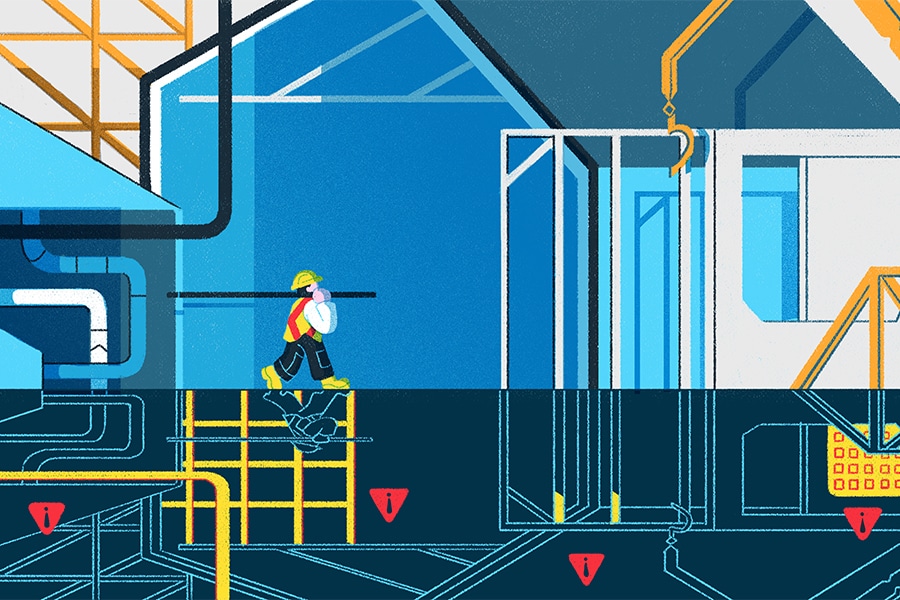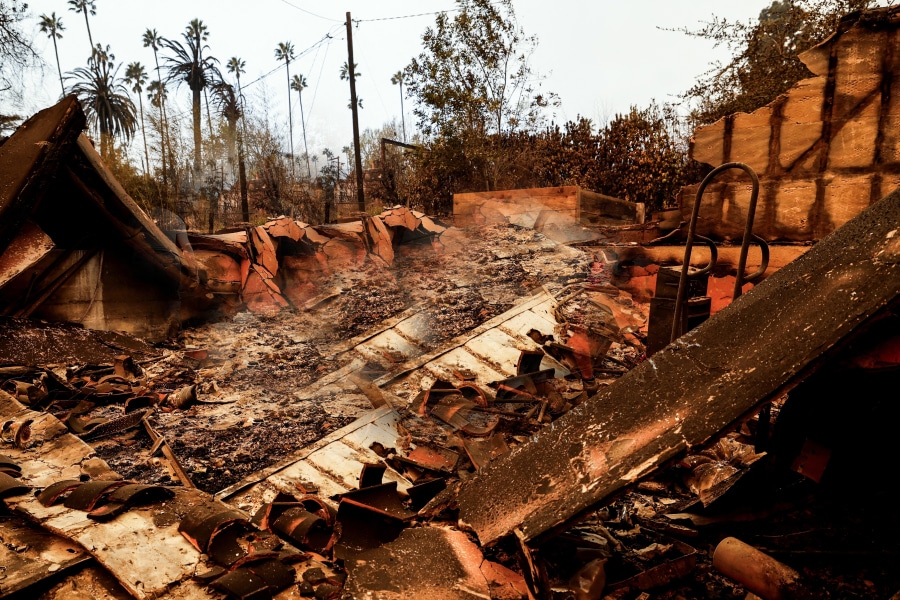Illustration by Wenting Li
For many people, the construction industry conjures up images of danger. This reputation certainly has roots in reality—while only 6% of the US labor force works in construction, 20% of all reported worker deaths are in the industry.
But according to a study co-authored by Dr. Diana Ceballos Ochoa, Boston University professor of public health, the most concerning danger faced by construction industry workers isn’t the day-to-day threat of a physical accident, but hidden contaminants that can be easily transferred between the jobsite and workers’ homes.
Here are risk factors to keep an eye out for and the steps organizations and individuals can take to mitigate them.
Reframing construction jobsite safety
Ceballos Ochoa said that the more subtle threat posed by jobsite contamination means it often garners less attention than the more obvious dangers posed by heavy equipment and improper use of protective gear.
“I think one of the things with construction is that there are a lot of injuries where safety takes such an important role, so that often takes precedence,” she said. “Sometimes things like lead and other hazards that cause more long-term chronic issues take a little bit of a backseat. This type of safety is not a commonsense concept, because you don’t see it with your bare eyes. You really have to understand that one drop every day for a year can poison your child. But because it doesn’t happen overnight, it’s not as urgent.”
RELATED:
This problem is more than just a failure of perception. “The other layer is the legislation that addresses occupational health in work sites is awfully outdated,” Ceballos Ochoa said. “It’s designed to protect workers from falling ill really quickly, focusing on the worker and their job task, but doesn’t address anything to do with long-term worker health.”
Ceballos Ochoa said that this outdated, compartmentalized approach to occupational legislation means that it is often siloed, with little coherence between construction safety programs creating dangerous gaps. As a result, “construction sites don’t always have a lead program,” she said. If they do, there may be contractors or other workers on site who aren’t looped in.
“There’s a lot of different scenarios where people can be exposed to lead and they can take it home,” Ceballos Ochoa said. “If I know I’m being exposed to lead, it’s possible that others working right beside me may not be in the lead program, but could be indirectly exposed. And with lead, it’s very tricky, because not only that one person working with lead materials who may get exposed, but depending on the work practices and the dust that they’re generating, other people can get exposed without their knowledge.” Furthermore, workers may not even know they’re in danger of contaminant exposure, leaving them unable to take mitigating action.
How policy can help close the gaps
The guidelines necessary for addressing site contaminant risks have been in place since the 1970s, according to Ceballos Ochoa. “OSHA has guidelines in terms of doing things to protect workers when they’re leaving the workplace,” she said. “We know well what works.”
The issues arise when it comes to putting this knowledge into practice. “What happens is that often these are not things that are emphasized in any training,” Ceballos Ochoa said. “And then there are the issues with enforcement on individual sites. Say, for example, you have a work site that is outdoors. The workers might not know where to change, where to wash their hands, and so on. These work sites can be so precarious and constantly changing, which makes it very difficult for the workers to have what they need to take precautions. So it’s not even that they don’t want to take precautions. It’s just actually really hard.”
Ceballos Ochoa said she believes that spreading awareness can make a difference. “If there was more awareness on this topic, I would hope that more workplaces provide more resources,” she said.
These gaps in worker education should also be addressed by policies with impact industrywide, Ceballos Ochoa said, replacing the current patchwork of individual legislation. “One of the things that I say in this paper is that we need an interagency work group to really tackle this issue, because it’s not a simple problem,” she said.
Fortunately, things are moving in the right direction. “The CDC has a lead prevention committee, and they’ve finally created a work group to look at this particular issue, bringing together people from various agencies with expertise to come up with a plan of action.”
What workers can do to minimize construction contamination
What can companies and individuals do to mitigate the risks of jobsite contamination as they wait for the new policies? Ceballos Ochoa said that shared accountability is vital.
“In the ideal world, workplaces should make it so easy for workers to clean up before they go home that it’s almost a given,” Ceballos Ochoa said. “They should be adopting policies where workers are given paid time to clean up, as well as all the resources, tools and space they need.”
With official jobsite policies in place, workers can be instructed to take steps to reduce their risks.
“Always change shoes, clothing as possible; wear layers when possible,” Ceballos Ochoa said. “If you don’t have a way to wash out at the work site, then carry wipes with you, and clean your car regularly. Just be very diligent to avoid tracking contamination to the house every day, so it becomes a habit.” Ultimately, Ceballos Ochoa said she believes that a cultural shift is needed. “I think that the culture needs to change so that workplaces realize that investing in the well-being of the workers is an investment toward the tenure of that worker,” she said. “It should be a shared responsibility, and it should have many layers. At the community, at the work site, at the home and legislatively.”












